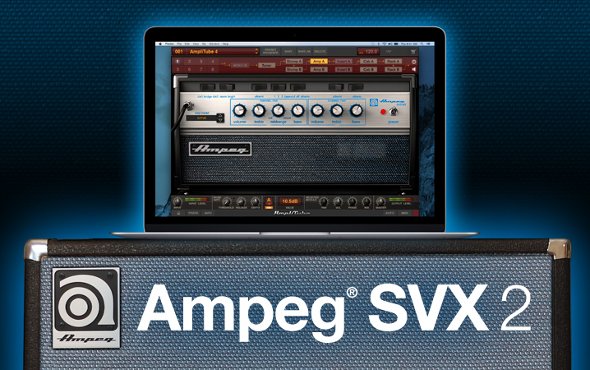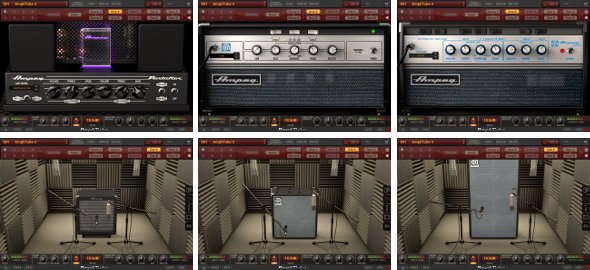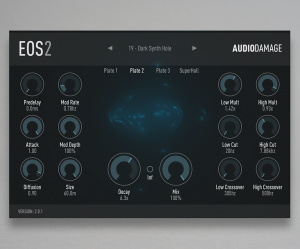 IK Multimedia, Hammond USA and Suzuki Music Corp. of Japan
IK Multimedia, Hammond USA and Suzuki Music Corp. of Japan
announce Leslie for AmpliTube and T-RackS on Mac/PC
Breakthrough technology offers ultra-realistic modeling to provide players and producers the best-sounding digital Leslie amps and cabs ever
January 25, 2018 – IK Multimedia is proud to announce a new collaboration with the product designers and R&D Team at Hammond USA and Suzuki Music Corp. of Japan, bringing the truly authentic sound of the legendary Leslie® amps and cabinets to the leading guitar amp and effects software, AmpliTube, and to the world class mixing and mastering processors in T-RackS.
AmpliTube Leslie and T-RackS Leslie offer the authentic sounds of 5 Leslie amps and 6 Leslie rotary-speaker cabinets that can be used for recording or playing live. Microphone distance and position control, precise level balancing, different amp and cab combinations, circuit overdriving, width, acceleration and deceleration control of the rotary speaker, horn/drum balance and more are included to give tracks the shimmer, charm, growl and character that are an unmistakable part of the Leslie sound.
Hammond USA Executive Vice President Peter Nguyen: “We are pleased to work with IK Multimedia in bringing the authentic Leslie sound to their AmpliTube and T-RackS software suites. We believe they are the right company to accurately and faithfully deliver the timeless and classic Leslie tone on a digital platform.”
There are many rotary speaker emulations. There’s just one Leslie®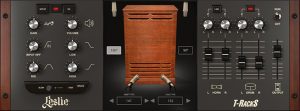
With the powerful combination of IK’s breakthrough technologies of Dynamic Interaction Modeling™, which can reproduce the subtlest interactions of an electronic circuit down to its tiniest component, together with Volumetric Response Modeling™, which recreates the real acoustic behavior of rotary-speaker cabinets, the IK and Hammond teams succeeded in delivering the true Leslie speaker sound without compromise.
AmpliTube Leslie and T-RackS Leslie have the distinct advantage over others with circuit-modeled amplifiers which are critical to recreating the signature tone of these incredible units, especially when overdriving the amp circuit, typical of genres like rock and blues. There are 5 amp models included: Leslie Type 147, Leslie Type 122 – vintage tube model; Leslie Type 122A – new tube model; Leslie 3300w – new hybrid amp and the Leslie G-37/Studio 12 – new hybrid amp.
All the speaker cabinets are faithfully reproduced using IK’s exclusive Volumetric Response Modeling™ technology, which is a combination of a new approach to impulse response recording, and the best modeling technology currently available. There are 6 rotary speaker models included: Leslie Type 147, 122, 122A; Leslie 3300w, Leslie G-37, Leslie Studio 12.
Everything under control
The virtual microphones in AmpliTube Leslie and T-RackS Leslie can be repositioned. This affects the perception the listener will have of the rotation, or “doppler effect”. Users can choose between a 90° mic position, which is the most common, giving a non-symmetric perception of the rotation, to the 180° mic position, which is less common, but heard on many famous recordings, and gives a more symmetric perception of the rotation. It is also possible to move the virtual microphones closer or further from the cabinet for even greater realism when recording. There is a full parametric EQ to further shape the sound to fit a variety of musical ideas even better.
Changing the rotation speed of the horn and drum is also possible allowing users to adjust the range of speed from slowest to fastest for their ideal performance settings. It is also possible to change the acceleration and deceleration speeds to control how quickly the speaker goes from “chorale” (slow) to “tremolo” (fast).
Pricing and availability
AmpliTube Leslie and T-RackS Leslie are expected to ship in March, 2018 and will be priced at $/€129.99* each. The Leslie Collection, which combines the AmpliTube and T-RackS versions, will be priced at $/€179.99. Upon release, the individual amps will also be available separately for $/€24.99 each and the cabinets will be available for $/€34.99 each. A single amp and cabinet purchased together will be priced at $/€49.99.
AmpliTube Leslie and T-RackS Leslie are available for preorder at a special introductory price of only $/€99.99 and the Leslie Collection can be pre-ordered for only $/€149.99.
* All prices excluding taxes
For more information about AmpliTube Leslie, please visit:
www.ikmultimedia.com/atleslie
www.ikmultimedia.com/atleslie/video
For more information about T-RackS Leslie, please visit:
www.ikmultimedia.com/trleslie
www.ikmultimedia.com/trleslie/video
For more information about the Leslie Collection, please visit:
www.ikmultimedia.com/lesliecollection




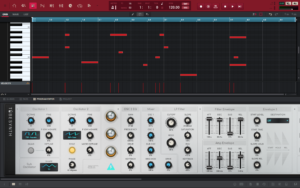 Bassline
Bassline


 IK Multimedia, Hammond USA and Suzuki Music Corp. of Japan
IK Multimedia, Hammond USA and Suzuki Music Corp. of Japan

